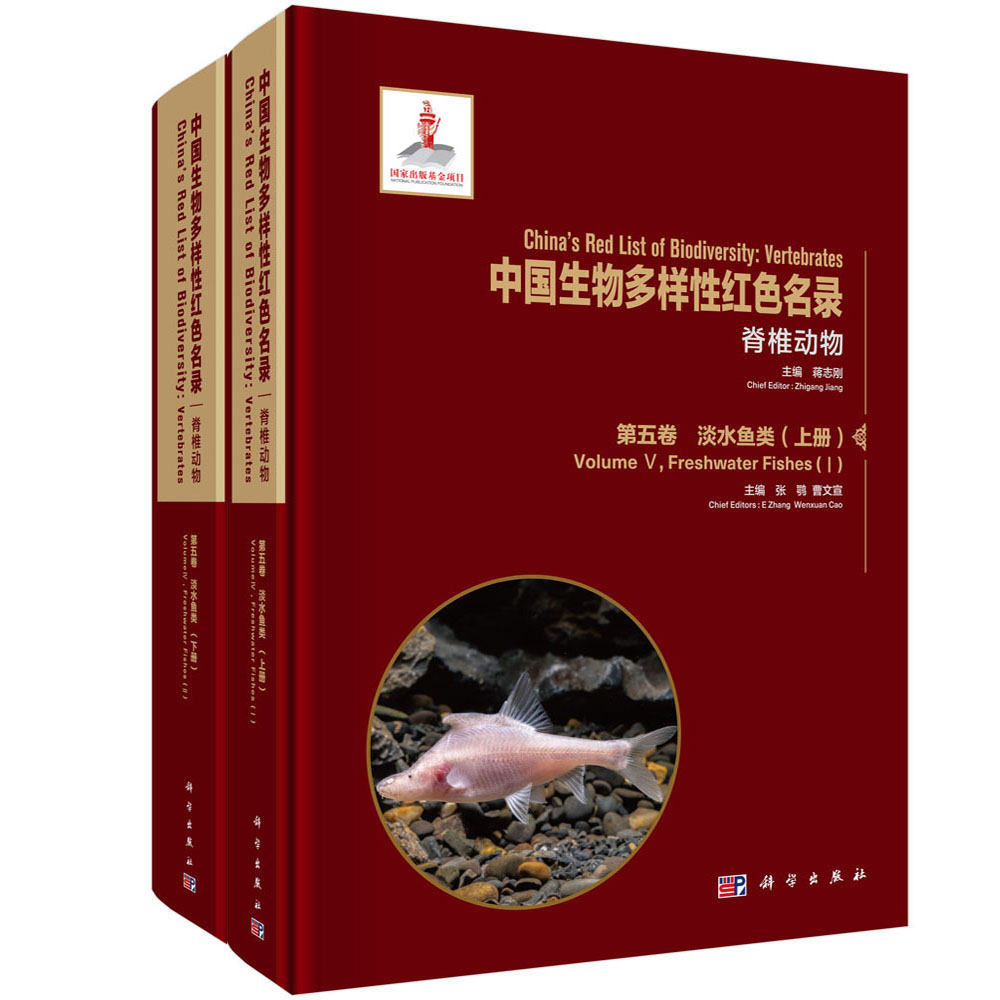
出版社: 科学
原售价: 928.00
折扣价: 733.20
折扣购买: 中国生物多样性红色名录(脊椎动物第5卷淡水鱼类上下汉英对照)(精)
ISBN: 9787030636560

总论
General Introduction
1 评估背景
1.1 淡水和淡水生物多样性价值
淡水和淡水生物是人类极其重要的自然资源。据估算,淡水仅占地球水资源总量的2.5%,仅有0.01%的水适合人类利用,存在于内陆江河、湖泊、水库、湿地和浅地层中。然而,淡水生态系统却维系了至少10万个物种,约占全球已知物种的6%(Dudgeon et al.,2006)。其单位面积物种数目要比陆地和海洋生态系统多得多。以鱼类为例, Lévêque等(2008)估计全球约有1.5万种淡水鱼类栖于仅覆盖地球表面1%的湖泊和河流中,而有大约1.6万种鱼类生活在占地球表面71%的海洋中。尽管海洋所含鱼类物种数较多,但是淡水中单位体积内的物种远比海水要丰富。大约平均15km3淡水就有超过1.1万个物种,而平均100,000km3的海水里才有一个物种,这说明淡水栖息地具有高生产力、地形学的多样性和地理隔离(Ormerod,2003)。
淡水生态系统是人类赖以生存的最基本的资源,它提供了清洁水源、食物及其他基本的生态服务,最终维持了人类幸福的生活。据估计,淡水提供的相关生态系统服务功能的年产值超过4万亿美元。目前,全球范围内普遍面临水资源短缺的问题。社会和经济发展加强了对有限淡水资源的有效利用,给淡水生态系统带来了巨大压力;同时,全球气候变暖可能会使淡水生物多样性危机加剧。淡水生态系统已经成为全球受威胁最严重的生态系统,其生物多样性减少速率远大于陆地生态系统(Sala et al.,2000)。据估计,淡水生物多样性灭绝的速率是陆地生物多样性的112~855倍(Collen et al.,2014; Tedesco et al.,2017)。半个世纪以来,淡水脊椎动物种群量下降了80%以上,减少速率是海洋和陆地生态系统的两倍。在全球已经被评估的28,000种淡水生物中,约有1/3的种类受到威胁;据估计,全球有3/4的内陆自然湿地在20世纪消失了。保护淡水和淡水生物多样性已经刻不容缓。为了避免或缓和人类活动对淡水生态系统和生物多样性的不利影响,迫切需要有关淡水生物多样性现状、分布和价值的详细信息。
1 Assessment Background
1.1 Values of Freshwater and Freshwater Biodiversity
Freshwater and freshwater organisms are extremely important natural resources for mankind. It is estimated that freshwater occupies only 2.5% of the total water resources on earth and only 0.01%, existing in inland rivers, lakes, reservoirs, wetlands and shallow strata, is suitable for human use. Freshwater ecosystems, however, support more than 100,000 species, making up 6% of the known species on the globe (Dudgeon et al.,2006). The number of species per unit area is much greater in freshwater ecosystems than in terrestrial or marine ecosystems. Take freshwater fishes as an example, Lévêque et al.(2008) estimated that approximately 15,000 species worldwide inhabit lakes and rivers that cover merely 1% of the earth’s surface, while the ocean, occupying 71% of the earth’s surface, includes the remaining 16,000 species. While there are more marine fishes, the fish diversity per unit volume is far higher in freshwater than in seawater. There are more than 11,000 fish species per 15km3 of freshwater, in contrast to merely one species per 100,000km3 in seawater, reflecting the high productivity, topographical diversity and geographical isolation of freshwater habitats (Ormerod,2003).
Freshwater ecosystems are the most basic natural resource for human survival. It provides clean water, food and other essential ecological services, and sustains human life. The estimated annual output value of the ecosystem services provided by freshwater exceeds 4 trillion US dollars. Water shortage is a grave global problem. The increase in social-economic developments have put huge pressure on freshwater ecosystems and demands efficient use of this resource; meanwhile, global warming is worsening this freshwater biodiversity crisis. Freshwater ecosystems have become the most imperiled ecosystems of the world and the global freshwater biodiversity is declining at far higher rate than that of terrestrial ecosystems (Sala et al.,2000). The extinction rate of freshwater biodiversity was estimated to be 112-855 times that of terrestrial biodiversity (Collen et al.,2014; Tedesco et al.,2017). During the past half century, freshwater vertebrates have diminished by at least 80%, which is twice the rate of either marine or terrestrial ecosystems. Among 28,000 freshwater fishes assessed globally for their imperiled status, one third of them are so far in peril. An inferred three-fourths of global inland natural wetlands have vanished during the 20th century. The conservation of freshwater and its biodiversity is urgently needed. To this end, detailed information about the status, distribution and value of freshwater biodiversity are urgently required to avoid or at least mitigate adverse impacts on freshwater ecosystems and biodiversity brought about by human interferences.
1.2 全球淡水鱼类红色名录评估进展
淡水鱼类大约占脊椎动物总数的25%,是全球生物多样性非常重要的组成部分(Reid et al.,2013)。现生脊椎动物约有55,000个物种,其中超过一半是现生鱼类,总数约为35,300种,而淡水鱼类有17,768种(Eschmeyer and Fong,2019)。尽管全球有515个鱼类科级分类单元,然而约有8,000个物种源自6个科;而在这些代表科中,约有6,100个物种(约76%)栖于淡水。尽管有关鱼类的知识正在迅速增加,但是仍然需要对这一群体进行更多分类研究。2000~2019年,7,000多个新的鱼类物种被描述或从物种的同物异名中“复活”,每年有超过300个鱼类新种被发现和描述(Eschmeyer and Fong,2019)。中国西南部及东南亚地区是全球范围内被描述的淡水鱼类新种数目最多的热点地区之一。
淡水鱼类是人类动物蛋白质的重要来源。据估计,全球小规模渔业捕捞量约有1/3的份额源自内陆淡水渔业(UNEP,2010)。淡水鱼类所面临的威胁远远超过了陆生脊椎动物,甚至比海水鱼类所受到的威胁更严重。虽然其物种数占世界脊椎动物的1/4(Carrizo et al.,2013),但是淡水鱼类多样性保护并未得到与其他脊椎动物同等的重视。20世纪60年代,世界自然保护联盟(International Union for Conservation of Nature,IUCN)便开始编制全球范围的受威胁物种红色名录(IUCN Red List of Threatened Species),但是至2002年仅评估了少量淡水鱼类物种的保护地位和受威胁状况。2002年 IUCN全球物种项目(Global Species Programme,GSP)设立了淡水生物多样性单元(Freshwater Biodiversity Unit, FBU),评估全球淡水生物物种受威胁状况,并于2004年成立淡水鱼类专家组(Freshwater Fish Specialist Group,FFSG),帮助搜集全球淡水鱼类信息。随后,淡水鱼类受威胁等级和保护地位评估工作得到迅速发展,评估物种数从2002年的660种上升到2011年的5,785种(Carrizo et al.,2013),被评估的种类涵盖170多个科;其中,包括匙吻鲟科和鲟科在内的27科所有物种均得到评估。截至2011年,IUCN评估的淡水鱼类中有60种灭绝、8种野外灭绝、1,679种濒临灭绝。已被评估的受威胁物种中,以鲤科(Cyprinidae)和慈鲷科(又称丽鱼科)(Cichlidae)为主,分别为474种和341种。直至2014年,IUCN完成了对非洲、欧洲、东喜马拉雅山地、印缅和蒙古等地区所有淡水鱼类物种